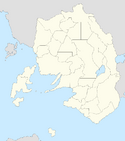Ionian Plateau
| This article is a stub. You can help IxWiki by expanding it. |
| This article is part of a series on the |
| Geography of Urcea |
|---|
 |
The Ionian Plateau is a pleateau which comprises much of eastern Urcea. While it is named for the Ionian Mountains which adjoin it to the north and east, the plateau is more extensive than the mountains themselves. It comprises the provinces of North Ionia, South Ionia, Kildarium, Hardinán, Ardthirium, Niallsland, and much of the Grand Duchy of Harren north of Cálfeld. The plateau stretches from the beginning of its escarpment to the west at the edge of the Valley to the Ionian Mountains in the north and east and the Magnag in the south. For much of its history, the Plateau was largely rural and dominated by semi-related clans, similar to Urcea's Estates. The region has been known for its fierce political and religious conservatism and loyalty to the Urcean monarchy. House de Weluta, the ruling family of Urcea, originated on the plateau. The Plateau has been closely culturally connected to the Valley since the period of Great Levantia.
Geography
The Plateau rises from the Valley as an escarpment and stretches to the north, south, and east, reaching the Ionian Mountains and Magnag, which serve as its limits. The central part of the plateau directly adjoining the Valley - an area which encompasses the provinces of South Ionia, Kildarium, Hardinán and northern Harren - is sometimes referred to as the "Inner Plateau", and this region is relatively flat. It has long been a suitable location for human habitation, experiencing slightly less humid and warm temperatures than the Valley due to its elevation, and with the flat land being home to a large variety of flora, it enjoys strong growing seasons. The Inner Plateau is more similar to the Valley in terms of its habitation and development patterns. The "Outer Plateau" - North Ionia, Niallsland, and Ardthirium - are mostly at higher elevations than the Inner Plateau and are full of rough valleys which provide less suitable land for agriculture and development, and accordingly these areas retain much of the rural character that defined the region for centuries. The Outer Plateaus are closer to the Ionian Mountains themselves, and in recent years these areas have developed significant ski related draws. The Outer Ionians in particular have had a long association with tourism from the Valley, dating back to the Ionian Hotel War.
History
The Plateau was the home of human settlement for long stretches during the prehistoric era. Gaelic people came to settle the region early in their history, prior to their presence in the Valley. Ancient Istroyan arrivals and later Adonerii settlers and explorers did not travel up the Plateau, gradually settling the Valley and elsewhere and trading with the plateau's Gaelic population. During the rise of Great Levantia, Gaels from the Valley and elsewhere were gradually pushed out of the Valley and other key parts of Levantia and were relocated to modern day Carna, Dericania, and the Plateau, which retained a Gaelic character deep into the Great Levantine age. Mining operations on the Plateau would introduce Latin settlers to the region, but they were never a majority of residents and most quickly married into the local population, undergoing the process of Urceanization as occurred elsewhere throughout southwestern Great Levantia. As the political authority and military power of Great Levantia began to wane, tribes and clans of Ionians began to encroach into the valley, and this encroachment is thought to have enhanced Urceanization by introducing new Gaelic rulers over the urbanized Latin population. Once Great Levantia collapsed, the Plateau divided itself into hundreds of tribal polities, most organized loosely around cities built by Great Levantia during the period of its existence but ruled over by local families that exercised control over herds of cattle and other animals, the primary form of wealth in early medieval Ionia.
Culture
Ionians consider themselves an integral part of the Urcean culture albeit with a strong regional identity which sets it apart from the Urceans living in the Valley.
Many of the themes of Ionian identity appear within Highlands literature, which refers to the literature of the people of the plateau.